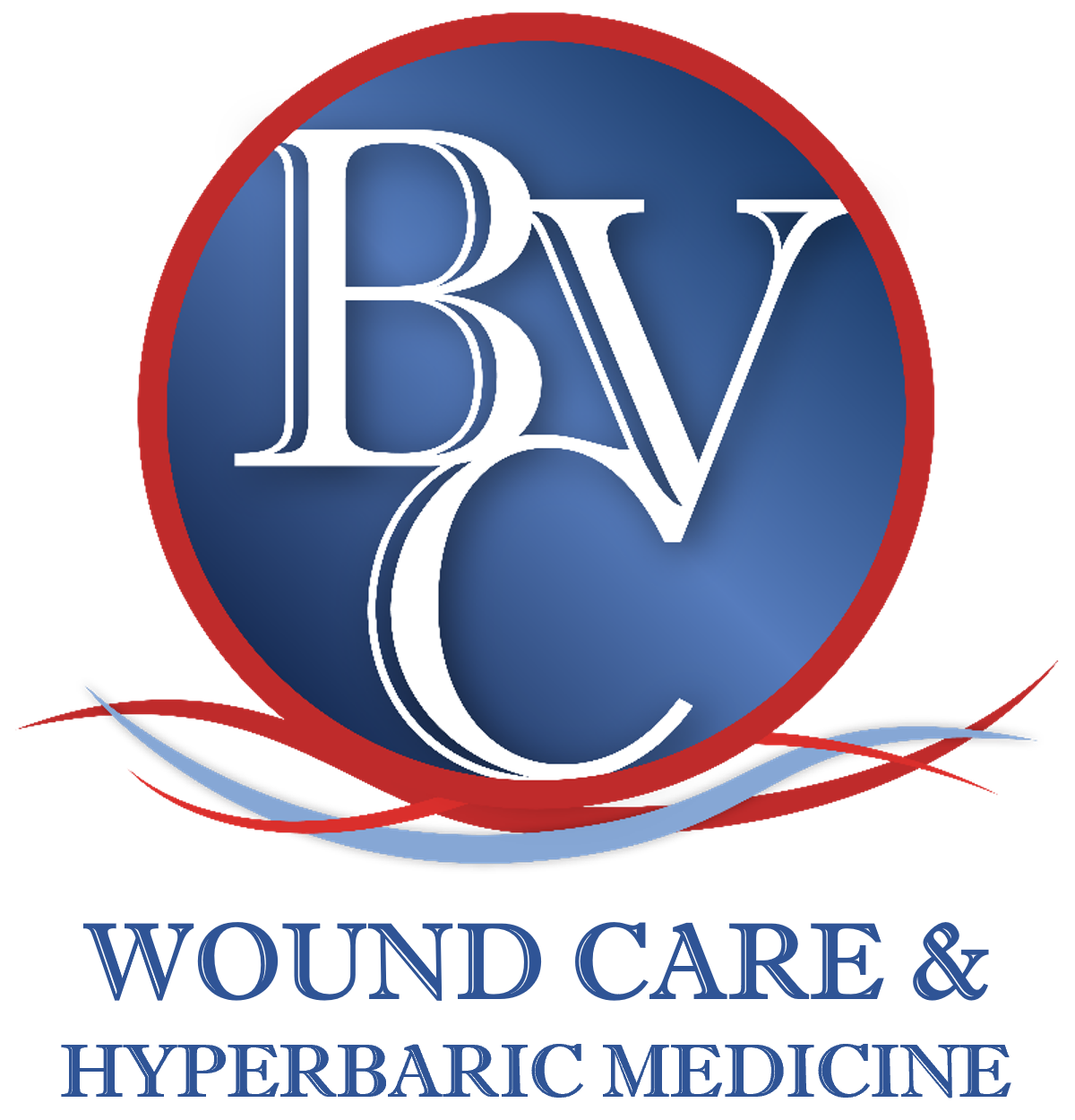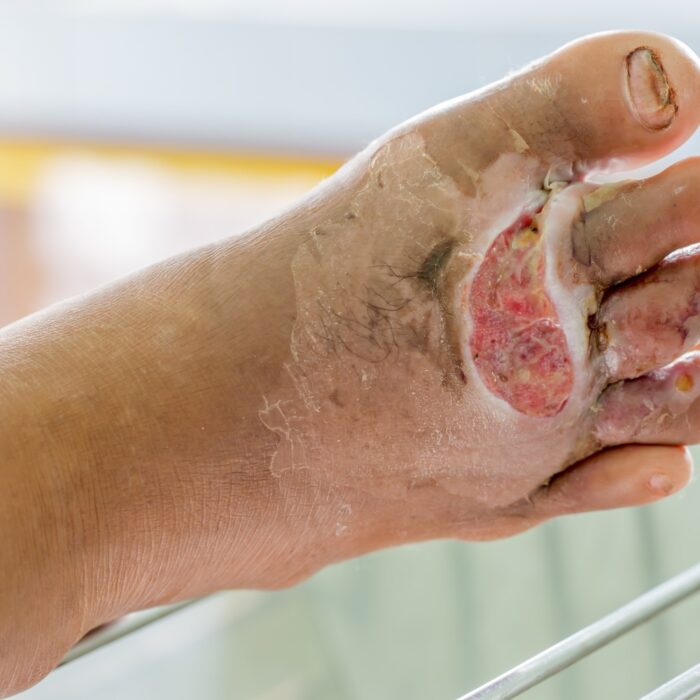Treatment Options
We utilize the most up-to-date approaches to wound healing
In 2018, Medicare reported that 8.2 million people had wounds, with or without infections, and that number is expected to increase exponentially each year. Our board certified team approach to wound healing assesses wounds, makes a determination regarding treatment based upon advanced medical technology, and coordinates care of any other primary or underlying medical condition. These may be associated with complications from diabetes and other vascular disorders. We utilize the most up-to-date approaches to wound healing and we remain current on new scientific advances in wound care.
Type of Wounds We Treat
- Cellulitis
- Crushing Injury Wounds
- Dermatitis
- Pressure Ulcers
- Vascular Insufficiency
- Burns
- Complex Abdominal Wounds
- Diabetic Ulcers
- Abrasions
- Lacerations
- Lymphedema
- Mohs Surgery Non-healing wounds
- Ostomy and Fistula Care
- Radiation Wounds
- Skin Tears
- Surgical Incisions
- Peripheral vascular disease
- Collagen vascular disease
Conditions & Treatments
Diabetic Foot Ulcer (DFU)
According to the American Podiatric Medical Association (APMA) – A diabetic foot ulcer is an open sore or wound that occurs in approximately 15 percent of patients with diabetes and is commonly located on the bottom of the foot. Patients who have diabetes for many years can develop neuropathy, a reduced or complete lack of ability to feel pain in the feet due to nerve damage caused by elevated blood glucose levels over time. Many times, the first thing you may notice is some drainage on your socks. Redness and swelling may also be associated with the ulceration and, if it has progressed significantly, odor may be present. A diabetic foot ulcer should be treated immediately to avoid complications including amputation.
Osteomyelitis
Osteomyelitis is a serious infection of the bone that can be either acute or chronic. It is an inflammatory process involving the bone and its structures caused by bacteria or other organisms that spread through the bloodstream, fractures, surgery or open sores (like DFU’s). Osteomyelitis can be treated by removing the infected bone, IV antibiotics and hyperbaric oxygen therapy. Osteomyelitis should be treated immediately to avoid complications including amputation.
Arterial Ulcer
Comfortable footwear is essential to the healthy progression of foot, ankle, and leg problems. Understanding how footwear can affect your health is an important step to recovery. We hope you consider the following footwear guidelines as a means to a better quality of life. The width and depth of shoes should allow for enough room to breathe without too much extra space. Footwear should not cause irritation, such as cramping or blisters. Your podiatrist may recommend custom footwear to provide proper sizing and support. Orthotics can be molded to your specific needs and provide an effective means of recovery. New shoes should be worn sparingly in order to adapt to a new feel. Similarly, it is important to change your shoes a few times a day, to reduce irritation and swelling. Wearing open-toed shoes should be discussed with your physician. Check your footwear for any foreign objects before putting them on your feet. Similar to footwear, socks should also fit properly and allow proper breathing. Choose a pair of socks with substantial padding to protect and support your feet. Never walk with bare feet!
Pressure Ulcer (Decubitus Ulcer, Bed Sore)
Pressure Ulcers are an injury to skin and underlying tissue resulting from prolonged pressure on the skin. They can develop quickly on people with a condition that limits their ability to change positions. Pressure ulcers often develop on the heels, ankles, hips, and tailbone in bedbound and wheelchair bound individuals. They can be difficult to treat because of patient positioning. Treatment includes managing infection, debriding dead tissue and cleaning and dressing the wound along with reducing pressure on the sore by frequent changes in position.
Venous Ulcer
Venous ulcers (venous stasis ulcers) are open wounds around the ankle or lower leg caused by poor blood flow in the leg veins. They are common in people who have varicose veins and/or a history of leg swelling. Valves in the legs that are supposed to keep blood flowing back to the heart begin to fail, causing blood and fluid pooling in the lower extremity. When this pooling of fluid occurs, it has negative effects on arterial blood flow, causing a breakdown in the skin and ulceration. Treatment would include treating the valves and bad veins to improve overall circulation, debridement of dead tissue and infection management.
Non-healing surgical wound
Surgical wounds that don’t heal in the normal way or as expected. This could be caused by many factors including lack of blood flow, radiation therapy in the area, infection, pressure to the area, diabetes or malnutrition. Helping these wounds heal quickly is essential to prevent further infection and subsequent surgery.
Late effects of radiation
Patients who have undergone radiation therapy as a treatment course for cancer can have specific problems associated with other tissues in the same area that was irradiated. This can happen in both soft tissues (soft tissue radionecrosis) and bones (osteoradionecrosis). The most common cases radiation induced tissue damage occur in the gastrointestinal tract (radiation proctitis, enteritis or colitis), the bladder (radiation cystitis) and the head and neck areas (osteoradionecrosis of the jaw). Additionally, radiation damage to tissue in the breast area after mastectomy could cause problems with the wounds healing after breast reconstruction surgery. Hyperbaric oxygen is a highly effective treatment for these conditions.
Skin Flaps or Grafts
Surgeries where skin is taken from one place on the body and placed on another site on the body is a graft. A flap is similar; however, it is not completely removed from its original site, just rotated to a nearby site. Both of these surgeries have the potential to be complicated by reduced blood flow to the flap/graft tissue. When this happens, the graft/flap can fail. Hyperbaric oxygen therapy can help to get oxygen to this tissue with compromised blood flow, helping it to live until the blood vessels begin to incorporate into the graft/flap tissue. It is essential to undergo treatments immediately once the tissue is identified as threatened to prevent graft/flap failure and subsequent surgery to repair.
Hyperbaric Treatment
A treatment where the patient is placed in a chamber and breathes 100% oxygen under a pressure greater than atmospheric pressure. Hyperbaric treatment helps to regrow blood vessels into damaged tissue, address infection, reduce swelling and oxygenate tissue that is being deprived of oxygen. It is a highly effective treatment for many of the wounds and conditions listed on this page.
Debridement
The removal of dead or devitalized tissue in a wound is needed to prepare the wound bed for new skin to begin to cover the wound. Debridement keeps the wound in an acute phase, triggering all of the body’s usual healing mechanisms to kick into high gear. Debridement can be done in the office setting in several ways including mechanical, excisional, or chemical.
Offloading
Wounds can be caused by pressure, and once present, can have trouble healing if the pressure is not reduced or removed. Pressure can be caused by prolonged lying or standing on bony prominences or shearing forces, such as sliding up and down on a bed surface. Offloading uses various methods to reduce or remove that pressure and shearing force. It is essential that diabetic foot ulcers are adequately offloaded in order to heal. Pressure sores typically found on the lower back or buttocks also need to be relieved of pressure as much as possible. Your physician or provider will provide specific options for your situation and ulcer type. If you don’t stay off a wound, it will not heal. Patients must remain complaint with the physician offloading orders.
Total Contact Cast
An offloading method mainly used on diabetic foot ulcers, a total contact cast consists of a rigid plaster or fiberglass cast that is form fitted to the calf. While walking, the majority of the body weight will be wedged into the calf of the cast and not onto the foot having the ulcer. Because it is also rigid, it removes many of the shearing forces seen while walking.
Wound V.A.C.
A negative pressure (suction) device that is placed over a wound to remove fluid, bacteria and promote blood vessels to enter wounded tissue. Additionally, it may help to mechanically pull the wound edges together and prepare the bed of the wound for new skin.
About Us
BVC Wound Care & Hyperbaric Medicine is a specialty outpatient clinic dedicated to treating many types of non-healing wounds.
About Us
BVC Wound Care & Hyperbaric Medicine is a specialty outpatient clinic dedicated to treating many types of non-healing wounds.




